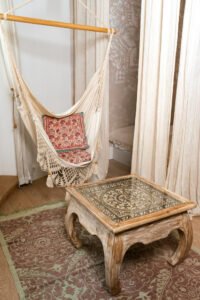Picture a scene from a classic Indian household: a crisp morning, the sun casting long shadows, and the rhythmic thwack-thwack of a bamboo stick against a heavy rug hanging over a railing. This familiar image of carpet beating isn’t just a memory of a time gone by; it’s a powerful symbol of simplicity, resourcefulness, and a deep connection to our homes.
This traditional carpet cleaning method, passed down through generations, represents a lifestyle that is both mindful and sustainable. It’s a practice that requires no electricity, no harsh chemicals, and no complex machinery—just a little bit of time and physical effort.
As more of us seek ways to live consciously and reduce our environmental impact, these ancestral practices are finding new relevance. This guide explores the heritage of traditional carpet cleaning, its surprising effectiveness, and how this old-world wisdom perfectly aligns with a modern, eco-friendly lifestyle.
The Heritage of Traditional Carpet Cleaning
Across India, from bustling city terraces to quiet village courtyards, the act of beating dust from a carpet has long been a household ritual. It was more than just a chore; it was woven into the fabric of family life. Often a seasonal activity, a deep clean before a festival, or a weekly routine involving multiple family members, this practice turned home maintenance into a communal and satisfying event.
This method stands in stark contrast to modern, machine-based cleaning. While today’s vacuum cleaners and chemical shampoos promise convenience, they often come at a cost to our health and the environment. The heritage of carpet beating reminds us of a time when cleaning was a direct, physical interaction with our belongings, fostering a greater appreciation for them.
How Traditional Carpet Beating Works
The process is beautifully simple yet remarkably effective, especially for handwoven rugs. It’s a genuine deep cleaning method that you can see and feel.
Here’s the step-by-step process:
- Take the Carpet Outdoors: The first step is to move the rug to an open, airy space. This prevents the dust from resettling inside your home.
- Hang it Securely: Drape the carpet over a sturdy clothesline, railing, or fence. Ensure it’s hung evenly to avoid stretching or damaging the fibers.
- Beat the Dust Out: Using a rattan rug beater, a clean broom handle, or a flexible bamboo stick, firmly beat the back of the rug. Work your way across the entire surface. You’ll see a cloud of dust, dander, and dirt emerge—a visible confirmation of the deep-seated particles being dislodged.
- Flip and Repeat: Once one side is done, flip the rug over and beat the front side to loosen any remaining surface dirt.
- Let it Air Out: Allow the rug to hang in the sun for an hour or two. The sunlight acts as a natural disinfectant, killing bacteria and dust mites while leaving the rug smelling fresh.
This method is particularly effective for handmade rugs because the vibrations loosen dirt trapped deep within the dense, hand-knotted fibers without the harsh suction or abrasive brushes of a machine.
Why Traditional Carpet Cleaning Is Sustainable
In a world grappling with environmental challenges, the eco-benefits of this age-old practice are more significant than ever.
- Zero Chemicals: Traditional carpet beating relies on physical force, not detergents. This protects your indoor air quality from volatile organic compounds (VOCs) found in many cleaning products and prevents harmful chemicals from entering our waterways.
- Zero Electricity: This method is entirely human-powered, reducing your home’s energy consumption and carbon footprint.
- No Machinery or Waste: By avoiding heavy, disposable machines and packaged cleaners, you reduce manufacturing and plastic waste.
- Longer Rug Life: Chemical cleaners can strip natural oils from wool and silk fibers, making them brittle over time. Gentle beating, however, preserves the integrity of handwoven rugs, helping them last for generations.
- Promotes Slow Living: This practice encourages a more mindful and deliberate approach to home care, fostering a deeper connection with your living space and the objects within it.
The Problem with Modern Cleaning Methods
While convenient, modern chemical and machine cleaning can cause significant issues, particularly for high-quality, natural-fiber rugs.
- Damage to Natural Fibers: Harsh detergents and aggressive machine brushes can damage the delicate structure of hand-spun wool and silk.
- Shorter Lifespan: Over time, these methods can weaken the rug’s foundation and cause colors to fade, shortening the life of a valuable handwoven carpet.
- Microplastic Shedding: For synthetic carpets, machine cleaning can cause microplastics to shed, which then enter our waterways and ecosystems.
- High Energy and Water Use: Carpet cleaning machines consume significant electricity and water, contributing to a larger environmental footprint.
Benefits for Handcrafted Rugs
Traditional cleaning is especially beneficial for the kind of artisanal pieces created at The Ambiente. Our rugs are crafted with natural dyes and hand-spun fibers, which thrive with gentle care.
- Preserves Weave and Texture: Beating helps maintain the tension and texture of the weave without the risk of pulling or snagging threads.
- Protects Natural Dyes: Avoiding chemicals ensures that the vibrant, natural dyes used in our rugs remain brilliant and do not bleed or fade.
- Keeps Rugs Airy and Fresh: This method fluffs up the pile and allows the fibers to breathe, restoring the rug’s natural softness.
- Reduces Allergens Naturally: By effectively removing dust, pollen, and dust mites, this practice helps create a healthier indoor environment, which is crucial for families with allergies or sensitivities.
The Ambiente’s Perspective: Protecting Craft and Planet
At The Ambiente, our Indian Rug Atelier is built on a foundation of respect for craftsmanship and the environment. We are proud to work with over 4,000 women weavers, using natural fibers to create rugs designed for longevity. Our commitment extends to how these creations are cared for.
Traditional carpet cleaning perfectly complements our ethos. It honors the painstaking work of our artisans by preserving the quality of their craft for years to come. We encourage our clients to adopt these sustainable care practices, ensuring their handcrafted rugs remain a beautiful and healthy part of their homes for generations.
Refresh Your Rugs, Respect the Planet
Embracing traditional carpet cleaning is more than just a nod to the past; it’s a conscious choice for a healthier, more sustainable future. It’s a reminder that sometimes the simplest methods are the most effective and that meaningful living begins right at home. By choosing handcrafted, natural-fiber rugs and caring for them with intention, you are not just decorating a space—you are cultivating a lifestyle that values craft, health, and our planet.
Care for your heirlooms the way our ancestors did, and they will reward you with timeless beauty and comfort.
[Explore Our Rug Collection]
Frequently Asked Questions
How often should I beat my carpet?
For rugs in high-traffic areas, a light beating every one to two months is ideal. For those in less-used spaces, cleaning two to three times a year is sufficient.
What tools are best for beating a rug?
A traditional rattan rug beater is designed for this purpose, but a sturdy, clean broom handle or a flexible bamboo stick also works well. Avoid anything with sharp edges that could damage the fibers.
Can all rugs be beaten?
Most handwoven wool and cotton rugs can be safely beaten. However, be cautious with very old, delicate, or antique pieces, especially silk rugs. For these, gentle shaking or professional cleaning is a safer option.
Does beating a rug replace vacuuming?
Beating provides a much deeper clean than most household vacuums, as it dislodges compacted dirt from the base of the rug. You can use a vacuum for regular surface cleaning between deep cleans.
Is this method safe for people with dust allergies?
Yes, it’s highly beneficial. By removing the rug from your living space to clean it, you prevent allergens from circulating indoors. The person performing the beating should consider wearing a mask if they are sensitive to dust.





